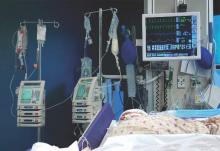AMSTERDAM – Neither cycling through a regular schedule of antibiotics on a unit-wide basis, nor randomly mixing them on a patient-level basis reduced the prevalence of antibiotic resistance in eight European intensive care units, a randomized study has determined.
Lead investigator Dr. Pleun Joppe van Duijn of University Medical Center Utrecht (the Netherlands), said he and his colleagues did, however, discover a few common sense findings that seemed to positively affect antibiotic resistance, including compliance with hand hygiene, shorter lengths of stay, staff ratio, and unit occupancy rate. He reported the results of his research at the European Society of Clinical Microbiology and Infectious Diseases annual congress.
Many ICUs in Europe have one preferred empirical treatment strategy which, Dr. van Duijn said, may create selective pressure for a single resistance type. “An alternative to this is a program of antibiotic rotation,” he noted. “By constantly changing the preferred first-line treatment, selective pressure is constantly changing, which may reduce selection of antibiotic resistance.”
Dr. van Duijn and his colleagues examined this idea in a randomized crossover trial that compared antibiotic cycling and mixing. The protocols employed three antibiotic classes: third- and fourth-generation cephalosporins, piperacillin/tazobactam, and carbapenems. The trial was conducted in eight ICUs in Belgium, Germany, France, Slovenia, and Portugal.
The sites were randomized to two 9-month interventions of cycling or mixing antibiotics, with a 1-month washout period between the two interventions. In cycling protocol, the preferred empiric antibiotic was changed every 6 weeks. In the mixing protocol, every consecutive patient received a different antibiotic. However, treating physicians were allowed to deviate from any protocol for patient safety or to optimize treatment.
The primary endpoint was the monthly prevalence of perineal and/or respiratory carriage of two classes of bacteria:
• Enterobacteriaceae species that were piperacillin/tazobactam–resistant or that showed extended spectrum beta-lactamase production.
• Pseudomonas aeruginosa and Acinetobacter species that were either piperacillin/tazobactam– or carbapenem-resistant.
In all, 8,945 patients were involved, with 4,238 exposed to cycling and 4,707 to mixing. Patients were a mean of 62 years old, with a mean 7-day length of stay. About 4.5% were already colonized with resistant bacteria upon admission. A quarter were on contact isolation; 2% were on both droplet and respiratory isolation.
The overall mortality rate was 11% and did not differ between the cycling and mixing groups (10.9% vs. 11.6%). Antibiotic resistance developed in 22.6% of the cycling group and 21.5% of the mixing group – not a significant difference. Neither protocol significantly reduced over time the amount of antibiotic resistance that was observed in the baseline period.
A multivariate analysis did, however, find a few things associated with resistance prevalence. Women were about 58% less likely to develop a resistant bacterial strain than men. Patients who stayed less than 48 hours had a 38% decreased risk of developing a resistant strain. Good staff compliance with hand hygiene reduced the risk by 12%, and having one-on-one nursing reduced it by 53%.
The study was funded by the European Community’s Seventh Framework Programme. Dr. van Duijn had no financial declarations.


